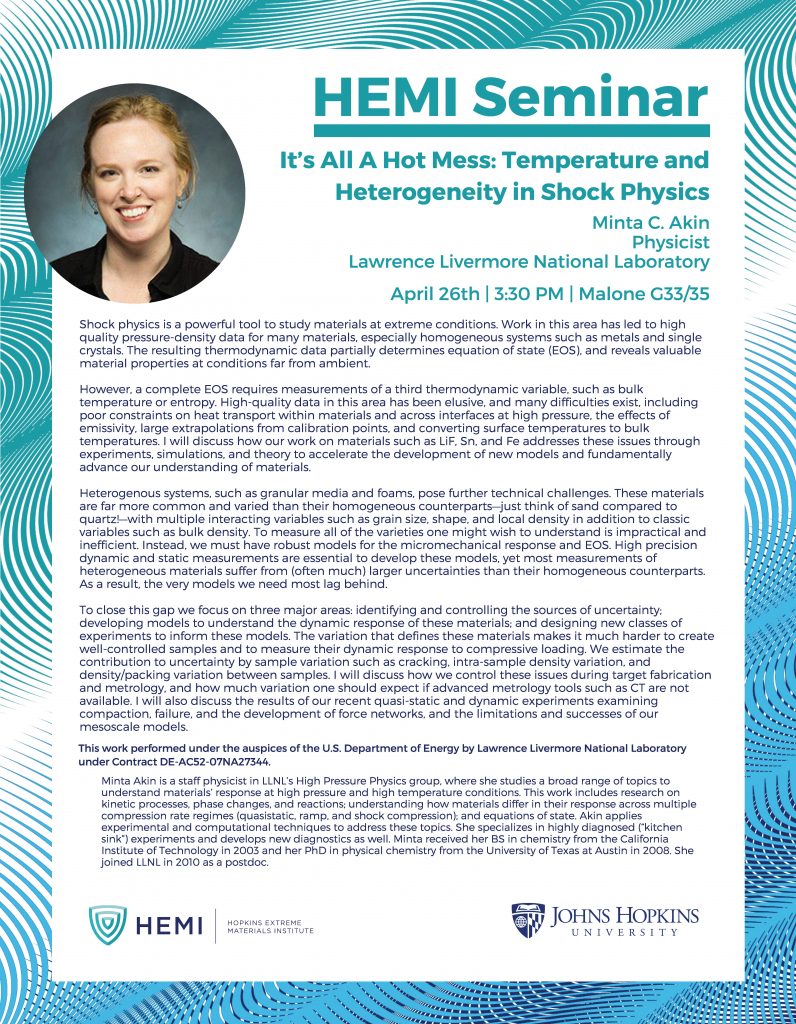April 26, 2019 @ 3:30 pm - 4:30 pm
It’s All A Hot Mess: Temperature and Heterogeneity in Shock Physics
Dr. Minta Akin
Physicist
Lawrence Livermore National Laboratory
Shock physics is a powerful tool to study materials at extreme conditions. Work in this area has led to high quality pressure-density data for many materials, especially homogeneous systems such as metals and single crystals. The resulting thermodynamic data partially determines equation of state (EOS), and reveals valuable material properties at conditions far from ambient.
However, a complete EOS requires measurements of a third thermodynamic variable, such as bulk temperature or entropy. High-quality data in this area has been elusive, and many difficulties exist, including poor constraints on heat transport within materials and across interfaces at high pressure, the effects of emissivity, large extrapolations from calibration points, and converting surface temperatures to bulk temperatures. I will discuss how our work on materials such as LiF, Sn, and Fe addresses these issues through experiments, simulations, and theory to accelerate the development of new models and fundamentally advance our understanding of materials.
Heterogenous systems, such as granular media and foams, pose further technical challenges. These materials are far more common and varied than their homogeneous counterparts—just think of sand compared to quartz!—with multiple interacting variables such as grain size, shape, and local density in addition to classic variables such as bulk density. To measure all of the varieties one might wish to understand is impractical and inefficient. Instead, we must have robust models for the micromechanical response and EOS. High precision dynamic and static measurements are essential to develop these models, yet most measurements of heterogeneous materials suffer from (often much) larger uncertainties than their homogeneous counterparts. As a result, the very models we need most lag behind.
To close this gap we focus on three major areas: identifying and controlling the sources of uncertainty; developing models to understand the dynamic response of these materials; and designing new classes of experiments to inform these models. The variation that defines these materials makes it much harder to create well-controlled samples and to measure their dynamic response to compressive loading. We estimate the contribution to uncertainty by sample variation such as cracking, intra-sample density variation, and density/packing variation between samples. I will discuss how we control these issues during target fabrication and metrology, and how much variation one should expect if advanced metrology tools such as CT are not available. I will also discuss the results of our recent quasi-static and dynamic experiments examining compaction, failure, and the development of force networks, and the limitations and successes of our mesoscale models.
This work performed under the auspices of the U.S. Department of Energy by Lawrence Livermore National Laboratory under Contract DE-AC52-07NA27344.
Minta Akin is a staff physicist in LLNL’s High Pressure Physics group, where she studies a broad range of topics to understand materials’ response at high pressure and high temperature conditions. This work includes research on kinetic processes, phase changes, and reactions; understanding how materials differ in their response across multiple compression rate regimes (quasistatic, ramp, and shock compression); and equations of state. Akin applies experimental and computational techniques to address these topics. She specializes in highly diagnosed (“kitchen sink”) experiments and develops new diagnostics as well. Minta received her BS in chemistry from the California Institute of Technology in 2003 and her PhD in physical chemistry from the University of Texas at Austin in 2008. She joined LLNL in 2010 as a postdoc.





